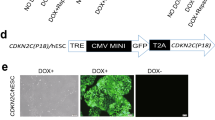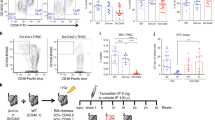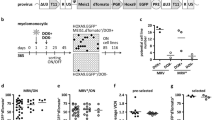Abstract
The transcription factor Evi1 has an outstanding role in the formation and transformation of hematopoietic cells. Its activation by chromosomal rearrangement induces a myelodysplastic syndrome with progression to acute myeloid leukemia of poor prognosis. Similarly, retroviral insertion-mediated upregulation confers a competitive advantage to transplanted hematopoietic cells, triggering clonal dominance or even leukemia. To study the molecular and functional response of primary murine hematopoietic progenitor cells to the activation of Evi1, we established an inducible lentiviral expression system. EVI1 had a biphasic effect with initial growth inhibition and retarded myeloid differentiation linked to enhanced survival of myeloblasts in long-term cultures. Gene expression microarray analysis revealed that within 24 h EVI1 upregulated ‘stemness’ genes characteristic for long-term hematopoietic stem cells (Aldh1a1, Abca1, Cdkn1b, Cdkn1c, Epcam, among others) but downregulated genes involved in DNA replication (Cyclins and their kinases, among others) and DNA repair (including Brca1, Brca2, Rad51). Cell cycle analysis demonstrated EVI1’s anti-proliferative effect to be strictly dose-dependent with accumulation of cells in G0/G1, but preservation of a small fraction of long-term proliferating cells. Although confined to cultured cells, our study contributes to new hypotheses addressing the mechanisms and molecular targets involved in preleukemic clonal dominance or leukemic transformation by Evi1.
This is a preview of subscription content, access via your institution
Access options
Subscribe to this journal
Receive 12 print issues and online access
$259.00 per year
only $21.58 per issue
Buy this article
- Purchase on Springer Link
- Instant access to full article PDF
Prices may be subject to local taxes which are calculated during checkout





Similar content being viewed by others
References
Morishita K, Parker DS, Mucenski ML, Jenkins NA, Copeland NG, Ihle JN . Retroviral activation of a novel gene encoding a zinc finger protein in IL-3-dependent myeloid leukemia cell lines. Cell 1988; 54: 831–840.
Li Z, Dullmann J, Schiedlmeier B, Schmidt M, von Kalle C, Meyer J et al. Murine leukemia induced by retroviral gene marking. Science 2002; 296: 497.
Kustikova O, Fehse B, Modlich U, Yang M, Dullmann J, Kamino K et al. Clonal dominance of hematopoietic stem cells triggered by retroviral gene marking. Science 2005; 308: 1171–1174.
Calmels B, Ferguson C, Laukkanen MO, Adler R, Faulhaber M, Kim HJ et al. Recurrent retroviral vector integration at the Mds1/Evi1 locus in nonhuman primate hematopoietic cells. Blood 2005; 106: 2530–2533.
Ott MG, Schmidt M, Schwarzwaelder K, Stein S, Siler U, Koehl U et al. Correction of X-linked chronic granulomatous disease by gene therapy, augmented by insertional activation of MDS1-EVI1, PRDM16 or SETBP1. Nat Med 2006; 12: 401–409.
Lugthart S, Groschel S, Beverloo HB, Kayser S, Valk PJ, van Zelderen-Bhola SL et al. Clinical, molecular, and prognostic significance of WHO type inv(3)(q21q26.2)/t(3;3)(q21;q26.2) and various other 3q abnormalities in acute myeloid leukemia. J Clin Oncol 2010; 28: 3890–3898.
Groschel S, Lugthart S, Schlenk RF, Valk PJ, Eiwen K, Goudswaard C et al. High EVI1 expression predicts outcome in younger adult patients with acute myeloid leukemia and is associated with distinct cytogenetic abnormalities. J Clin Oncol 2010; 28: 2101–2107.
Goyama S, Yamamoto G, Shimabe M, Sato T, Ichikawa M, Ogawa S et al. Evi-1 is a critical regulator for hematopoietic stem cells and transformed leukemic cells. Cell Stem Cell 2008; 3: 207–220.
Zhang Y, Stehling-Sun S, Lezon-Geyda K, Juneja SC, Coillard L, Chatterjee G et al. PR-domain-containing Mds1-Evi1 is critical for long-term hematopoietic stem cell function. Blood 2011; 118: 3853–3861.
Kataoka K, Sato T, Yoshimi A, Goyama S, Tsuruta T, Kobayashi H et al. Evi1 is essential for hematopoietic stem cell self-renewal, and its expression marks hematopoietic cells with long-term multilineage repopulating activity. J Exp Med 2011; 208: 2403–2416.
Modlich U, Kustikova OS, Schmidt M, Rudolph C, Meyer J, Li Z et al. Leukemias following retroviral transfer of multidrug resistance 1 (MDR1) are driven by combinatorial insertional mutagenesis. Blood 2005; 105: 4235–4246.
Maetzig T, Brugman MH, Bartels S, Heinz N, Kustikova OS, Modlich U et al. Polyclonal fluctuation of lentiviral vector-transduced and expanded murine hematopoietic stem cells. Blood 2011; 117: 3053–3064.
Wolf S, Rudolph C, Morgan M, Busche G, Salguero G, Stripecke R et al. Selection for Evi1 activation in myelomonocytic leukemia induced by hyperactive signaling through wild-type NRas. Oncogene, e-pub ahead of print 30 July 2012; doi: 10.1038/onc.2012.329.
Haferlach C, Bacher U, Haferlach T, Dicker F, Alpermann T, Kern W et al. The inv(3)(q21q26)/t(3;3)(q21;q26) is frequently accompanied by alterations of the RUNX1, KRAS and NRAS and NF1 genes and mediates adverse prognosis both in MDS and in AML: a study in 39 cases of MDS or AML. Leukemia 2011; 25: 874–877.
Konrad TA, Karger A, Hackl H, Schwarzinger I, Herbacek I, Wieser R . Inducible expression of EVI1 in human myeloid cells causes phenotypes consistent with its role in myelodysplastic syndromes. J Leukoc Biol 2009; 86: 813–822.
Yoshimi A, Goyama S, Watanabe-Okochi N, Yoshiki Y, Nannya Y, Nitta E et al. Evi1 represses PTEN expression and activates PI3K/AKT/mTOR via interactions with polycomb proteins. Blood 2011; 117: 3617–3628.
Du Y, Jenkins NA, Copeland NG . Insertional mutagenesis identifies genes that promote the immortalization of primary bone marrow progenitor cells. Blood 2005; 106: 3932–3939.
Modlich U, Bohne J, Schmidt M, von Kalle C, Knoss S, Schambach A et al. Cell-culture assays reveal the importance of retroviral vector design for insertional genotoxicity. Blood 2006; 108: 2545–2553.
Sellers S, Gomes TJ, Larochelle A, Lopez R, Adler R, Krouse A et al. Ex vivo expansion of retrovirally transduced primate CD34+ cells results in overrepresentation of clones with MDS1/EVI1 insertion sites in the myeloid lineage after transplantation. Mol Ther 2010; 18: 1633–1639.
Magnusson M, Brun AC, Miyake N, Larsson J, Ehinger M, Bjornsson JM et al. HOXA10 is a critical regulator for hematopoietic stem cells and erythroid/megakaryocyte development. Blood 2007; 109: 3687–3696.
Gossen M, Bujard H . Tight control of gene expression in mammalian cells by tetracycline-responsive promoters. Proc Natl Acad Sci USA 1992; 89: 5547–5551.
Schambach A, Bohne J, Chandra S, Will E, Margison GP, Williams DA et al. Equal potency of gammaretroviral and lentiviral SIN vectors for expression of O6-methylguanine-DNA methyltransferase in hematopoietic cells. Mol Ther 2006; 13: 391–400.
Li Z, Schwieger M, Lange C, Kraunus J, Sun H, van den Akker E et al. Predictable and efficient retroviral gene transfer into murine bone marrow repopulating cells using a defined vector dose. Exp Hematol 2003; 31: 1206–1214.
Zhang CC, Lodish HF . Murine hematopoietic stem cells change their surface phenotype during ex vivo expansion. Blood 2005; 105: 4314–4320.
Gentleman RC, Carey VJ, Bates DM, Bolstad B, Dettling M, Dudoit S et al. Bioconductor: open software development for computational biology and bioinformatics. Genome Biol 2004; 5: R80.
Kauffmann A, Gentleman R, Huber W . arrayQualityMetrics--a bioconductor package for quality assessment of microarray data. Bioinformatics 2009; 25: 415–416.
Gautier L, Cope L, Bolstad BM, Irizarry RA . affy--analysis of Affymetrix GeneChip data at the probe level. Bioinformatics 2004; 20: 307–315.
Smyth G, Subramanian A, Tamayo P, Mootha VK, Mukherjee S, Ebert BL et al. Limma: linear models for microarray data. In: Gentleman R, (ed) Bioinformatics and Computational Biology Solutions Using R and Bioconductor. Springer: New York, 2005; pp 397–420.
Subramanian A, Tamayo P, Mootha VK, Mukherjee S, Ebert BL, Gillette MA et al. Gene set enrichment analysis: a knowledge-based approach for interpreting genome-wide expression profiles. Proc Natl Acad Sci USA 2005; 102: 15545–15550.
Culhane AC, Schwarzl T, Sultana R, Picard KC, Picard SC, Lu TH et al. GeneSigDB-a curated database of gene expression signatures. Nucleic Acids Res 2010; 38: D716–D725.
Modlich U, Navarro S, Zychlinski D, Maetzig T, Knoess S, Brugman MH et al. Insertional transformation of hematopoietic cells by self-inactivating lentiviral and gammaretroviral vectors. Mol Ther 2009; 17: 1919–1928.
Montini E, Cesana D, Schmidt M, Sanvito F, Bartholomae CC, Ranzani M et al. The genotoxic potential of retroviral vectors is strongly modulated by vector design and integration site selection in a mouse model of HSC gene therapy. J Clin Invest 2009; 119: 964–975.
Forsberg EC, Prohaska SS, Katzman S, Heffner GC, Stuart JM, Weissman IL . Differential expression of novel potential regulators in hematopoietic stem cells. PLoS Genet 2005; 1: e28.
Jaitin DA, Roisman LC, Jaks E, Gavutis M, Piehler J, Van der Heyden J et al. Inquiring into the differential action of interferons (IFNs): an IFN-alpha2 mutant with enhanced affinity to IFNAR1 is functionally similar to IFN-beta. Mol Cell Biol 2006; 26: 1888–1897.
Kulaeva OI, Draghici S, Tang L, Kraniak JM, Land SJ, Tainsky MA . Epigenetic silencing of multiple interferon pathway genes after cellular immortalization. Oncogene 2003; 22: 4118–4127.
Dauer DJ, Ferraro B, Song L, Yu B, Mora L, Buettner R et al. Stat3 regulates genes common to both wound healing and cancer. Oncogene 2005; 24: 3397–3408.
Einav U, Tabach Y, Getz G, Yitzhaky A, Ozbek U, Amariglio N et al. Gene expression analysis reveals a strong signature of an interferon-induced pathway in childhood lymphoblastic leukemia as well as in breast and ovarian cancer. Oncogene 2005; 24: 6367–6375.
Mathew R, Seiler MP, Scanlon ST, Mao AP, Constantinides MG, Bertozzi-Villa C et al. BTB-ZF factors recruit the E3 ligase cullin 3 to regulate lymphoid effector programs. Nature 2012; 491: 618–621.
Rockova V, Abbas S, Wouters BJ, Erpelinck CA, Beverloo HB, Delwel R et al. Risk stratification of intermediate-risk acute myeloid leukemia: integrative analysis of a multitude of gene mutation and gene expression markers. Blood 2011; 118: 1069–1076.
Li Q, Haigis KM, McDaniel A, Harding-Theobald E, Kogan SC, Akagi K et al. Hematopoiesis and leukemogenesis in mice expressing oncogenic NrasG12D from the endogenous locus. Blood 2011; 117: 2022–2032.
Mirzayans R, Andrais B, Scott A, Murray D . New insights into p53 signaling and cancer cell response to DNA damage: implications for cancer therapy. J Biomed Biotechnol, e-pub ahead of print 15 July 2012; doi:10.1155/2012/170325.
Fridman AL, Tainsky MA . Critical pathways in cellular senescence and immortalization revealed by gene expression profiling. Oncogene 2008; 27: 5975–5987.
Karakaya K, Herbst F, Ball C, Glimm H, Krämer A, Löffler H . Overexpression of EVI1 interferes with cytokinesis and leads to accumulation of cells with supernumerary centrosomes in G0/1 phase. Cell Cycle 2012; 11: 3492–3503.
Stein S, Ott MG, Schultze-Strasser S, Jauch A, Burwinkel B, Kinner A et al. Genomic instability and myelodysplasia with monosomy 7 consequent to EVI1 activation after gene therapy for chronic granulomatous disease. Nat Med 2010; 16: 198–204.
Kohlmann AL, Bullinger C, Thiede M, Schaich S, Schnittger KD, Döhner K et al. Gene expression profiling in AML with normal karyotype can predict mutations for molecular markers and allows novel insights into perturbed biological pathways. Leukemia 2010; 24: 1216–1220.
Alimonti A, Nardella C, Chen Z, Clohessy JG, Carracedo A, Trotman LC et al. A novel type of cellular senescence that can be enhanced in mouse models and human tumor xenografts to suppress prostate tumorigenesis. J Clin Invest 2010; 120: 681–693.
Kustikova OS, Geiger H, Li Z, Brugman MH, Chambers SM, Shaw CA et al. Retroviral vector insertion sites associated with dominant hematopoietic clones mark ‘stemness’ pathways. Blood 2007; 109: 1897–1907.
Matsumoto A, Takeishi S, Kanie T, Susaki E, Onoyama I, Tateishi Y et al. p57 is required for quiescence and maintenance of adult hematopoietic stem cells. Cell Stem Cell 2011; 9: 262–271.
Aiuti A, Cattaneo F, Galimberti S, Benninghoff U, Cassani B, Callegaro L et al. Gene therapy for immunodeficiency due to adenosine deaminase deficiency. N Engl J Med 2009; 360: 447–458.
Gaspar HB, Bjorkegren E, Parsley K, Gilmour KC, King D, Sinclair J et al. Successful reconstitution of immunity in ADA-SCID by stem cell gene therapy following cessation of PEG-ADA and use of mild preconditioning. Mol Ther 2006; 14: 505–513.
Hacein-Bey-Abina S, Garrigue A, Wang GP, Soulier J, Lim A, Morillon E et al. Insertional oncogenesis in 4 patients after retrovirus-mediated gene therapy of SCID-X1. J Clin Invest 2008; 118: 3132–3142.
Boztug K, Schmidt M, Schwarzer A, Banerjee PP, Diez IA, Dewey RA et al. Stem-cell gene therapy for the Wiskott-Aldrich syndrome. N Engl J Med 2010; 363: 1918–1927.
Aguilo F, Avagyan S, Labar AS, Sevilla A, Lee DF, Kumar P et al. Prdm16 is a physiological regulator of hematopoietic stem cells. Blood 2011; 117: 5057–5066.
Chuikov S, Levi BP, Smith ML, Morrison SJ . Prdm16 promotes stem cell maintenance in multiple tissues, partly by regulating oxidative stress. Nat Cell Biol 2010; 12: 999–1006.
Modlich U, Schambach A, Brugman MH, Wicke DC, Knoess S, Li Z et al. Leukemia induction after a single retroviral vector insertion in Evi1 or Prdm16. Leukemia 2008; 22: 1519–1528.
Tesio M, Trumpp A . Breaking the cell cycle of HSCs by p57 and friends. Cell Stem Cell 2011; 9: 187–192.
Acknowledgements
This work was supported by the German Research Foundation (DFG, Research priority program 1230 and cluster of excellence REBIRTH) and the European Union (grants Clinigene and CELL-PID). We thank Rena-Mareike Struss, Institute of Experimental Hematology, Hannover Medical School, Hannover, Germany, for help with breeding and genotyping of mice. We thank the Cell Sorting Unit of Hannover Medical School for support in sorting experiments. We are grateful to Marcel Tauscher, Institute of Cell and Molecular Pathology, Hannover Medical School, Hannover, Germany, for support in performing array-CGH analysis.
Author Contributions
OSK, MS, A Schwarzer, A Schambach, TCH, MHB, NH, DS, MY and ZL performed experiments. SG and IR performed mathematical modeling. All authors analyzed data. CB and OSK designed the study, and wrote the manuscript. A Schwarzer, MHB, NH, ZL, SG, DS, BS contributed to writing the manuscript.
Author information
Authors and Affiliations
Corresponding author
Ethics declarations
Competing interests
The authors declare no conflict of interest.
Additional information
Supplementary Information accompanies the paper on the Leukemia website
Supplementary information
Rights and permissions
About this article
Cite this article
Kustikova, O., Schwarzer, A., Stahlhut, M. et al. Activation of Evi1 inhibits cell cycle progression and differentiation of hematopoietic progenitor cells. Leukemia 27, 1127–1138 (2013). https://doi.org/10.1038/leu.2012.355
Received:
Revised:
Accepted:
Published:
Issue Date:
DOI: https://doi.org/10.1038/leu.2012.355
Keywords
This article is cited by
-
AKT inhibition sensitizes EVI1 expressing colon cancer cells to irinotecan therapy by regulating the Akt/mTOR axis
Cellular Oncology (2022)
-
EVI1 dysregulation: impact on biology and therapy of myeloid malignancies
Blood Cancer Journal (2021)
-
Conditionally immortalised leukaemia initiating cells co-expressing Hoxa9/Meis1 demonstrate microenvironmental adaptation properties ex vivo while maintaining myelomonocytic memory
Scientific Reports (2021)
-
EVI1 oncoprotein expression and CtBP1-association oscillate through the cell cycle
Molecular Biology Reports (2020)
-
EVI1 phosphorylation at S436 regulates interactions with CtBP1 and DNMT3A and promotes self-renewal
Cell Death & Disease (2020)



